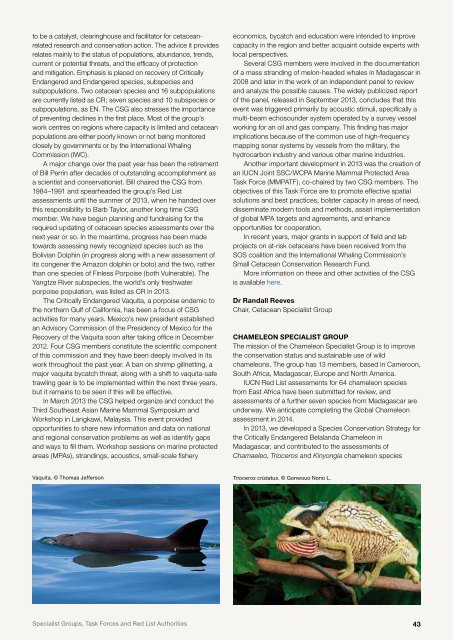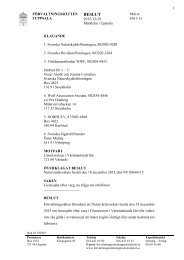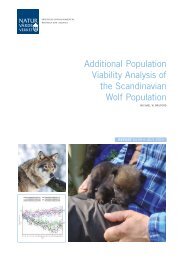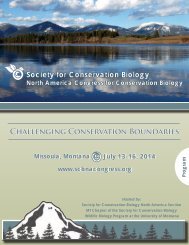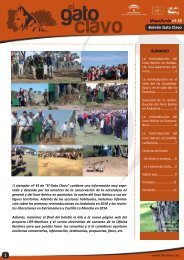1oC3Dbk
1oC3Dbk
1oC3Dbk
You also want an ePaper? Increase the reach of your titles
YUMPU automatically turns print PDFs into web optimized ePapers that Google loves.
to be a catalyst, clearinghouse and facilitator for cetaceanrelated<br />
research and conservation action. The advice it provides<br />
relates mainly to the status of populations, abundance, trends,<br />
current or potential threats, and the efficacy of protection<br />
and mitigation. Emphasis is placed on recovery of Critically<br />
Endangered and Endangered species, subspecies and<br />
subpopulations. Two cetacean species and 16 subpopulations<br />
are currently listed as CR; seven species and 10 subspecies or<br />
subpopulations, as EN. The CSG also stresses the importance<br />
of preventing declines in the first place. Most of the group’s<br />
work centres on regions where capacity is limited and cetacean<br />
populations are either poorly known or not being monitored<br />
closely by governments or by the International Whaling<br />
Commission (IWC).<br />
A major change over the past year has been the retirement<br />
of Bill Perrin after decades of outstanding accomplishment as<br />
a scientist and conservationist. Bill chaired the CSG from<br />
1984–1991 and spearheaded the group’s Red List<br />
assessments until the summer of 2013, when he handed over<br />
this responsibility to Barb Taylor, another long time CSG<br />
member. We have begun planning and fundraising for the<br />
required updating of cetacean species assessments over the<br />
next year or so. In the meantime, progress has been made<br />
towards assessing newly recognized species such as the<br />
Bolivian Dolphin (in progress along with a new assessment of<br />
its congener the Amazon dolphin or boto) and the two, rather<br />
than one species of Finless Porpoise (both Vulnerable). The<br />
Yangtze River subspecies, the world’s only freshwater<br />
porpoise population, was listed as CR in 2013.<br />
The Critically Endangered Vaquita, a porpoise endemic to<br />
the northern Gulf of California, has been a focus of CSG<br />
activities for many years. Mexico’s new president established<br />
an Advisory Commission of the Presidency of Mexico for the<br />
Recovery of the Vaquita soon after taking office in December<br />
2012. Four CSG members constitute the scientific component<br />
of this commission and they have been deeply involved in its<br />
work throughout the past year. A ban on shrimp gillnetting, a<br />
major vaquita bycatch threat, along with a shift to vaquita-safe<br />
trawling gear is to be implemented within the next three years,<br />
but it remains to be seen if this will be effective.<br />
In March 2013 the CSG helped organize and conduct the<br />
Third Southeast Asian Marine Mammal Symposium and<br />
Workshop in Langkawi, Malaysia. This event provided<br />
opportunities to share new information and data on national<br />
and regional conservation problems as well as identify gaps<br />
and ways to fill them. Workshop sessions on marine protected<br />
areas (MPAs), strandings, acoustics, small-scale fishery<br />
economics, bycatch and education were intended to improve<br />
capacity in the region and better acquaint outside experts with<br />
local perspectives.<br />
Several CSG members were involved in the documentation<br />
of a mass stranding of melon-headed whales in Madagascar in<br />
2008 and later in the work of an independent panel to review<br />
and analyze the possible causes. The widely publicized report<br />
of the panel, released in September 2013, concludes that this<br />
event was triggered primarily by acoustic stimuli, specifically a<br />
multi-beam echosounder system operated by a survey vessel<br />
working for an oil and gas company. This finding has major<br />
implications because of the common use of high-frequency<br />
mapping sonar systems by vessels from the military, the<br />
hydrocarbon industry and various other marine industries.<br />
Another important development in 2013 was the creation of<br />
an IUCN Joint SSC/WCPA Marine Mammal Protected Area<br />
Task Force (MMPATF), co-chaired by two CSG members. The<br />
objectives of this Task Force are to promote effective spatial<br />
solutions and best practices, bolster capacity in areas of need,<br />
disseminate modern tools and methods, assist implementation<br />
of global MPA targets and agreements, and enhance<br />
opportunities for cooperation.<br />
In recent years, major grants in support of field and lab<br />
projects on at-risk cetaceans have been received from the<br />
SOS coalition and the International Whaling Commission’s<br />
Small Cetacean Conservation Research Fund.<br />
More information on these and other activities of the CSG<br />
is available here.<br />
Dr Randall Reeves<br />
Chair, Cetacean Specialist Group<br />
Chameleon Specialist Group<br />
The mission of the Chameleon Specialist Group is to improve<br />
the conservation status and sustainable use of wild<br />
chameleons. The group has 13 members, based in Cameroon,<br />
South Africa, Madagascar, Europe and North America.<br />
IUCN Red List assessments for 64 chameleon species<br />
from East Africa have been submitted for review, and<br />
assessments of a further seven species from Madagascar are<br />
underway. We anticipate completing the Global Chameleon<br />
assessment in 2014.<br />
In 2013, we developed a Species Conservation Strategy for<br />
the Critically Endangered Belalanda Chameleon in<br />
Madagascar, and contributed to the assessments of<br />
Chamaeleo, Trioceros and Kinyongia chameleon species<br />
Vaquita. © Thomas Jefferson Trioceros cristatus. © Gonwouo Nono L.<br />
Specialist Groups, Task Forces and Red List Authorities<br />
43


